 I had only a sketchy knowledge of Tallinn and Estonian history and folklore before we began our tour of the old town. We had a really wonderful guide, Merica, who was a local schoolteacher and relished in sharing some of the fantastic stories and legends as we explored her beloved hometown. One of my favourites was the explanation for the centre of Tallinn old town being perched on top of a hill rather incongruously as all around was flat. The legend goes that Kalev, a giant, routinely strode across the sea to bring forests of wood with which to build Tallinn. On his death his wife Linda (yes, I was surprised also) was so devastated she started heaping large boulders onto her late lamented husband’s grave (let us assume she was a giantess or this story doesn’t work).
I had only a sketchy knowledge of Tallinn and Estonian history and folklore before we began our tour of the old town. We had a really wonderful guide, Merica, who was a local schoolteacher and relished in sharing some of the fantastic stories and legends as we explored her beloved hometown. One of my favourites was the explanation for the centre of Tallinn old town being perched on top of a hill rather incongruously as all around was flat. The legend goes that Kalev, a giant, routinely strode across the sea to bring forests of wood with which to build Tallinn. On his death his wife Linda (yes, I was surprised also) was so devastated she started heaping large boulders onto her late lamented husband’s grave (let us assume she was a giantess or this story doesn’t work).
 Shortly after her extensive efforts had created the hill Tallinn is famous for, she let a boulder slip from her apron and in her grief climbed on top of this fallen boulder and cried and cried mourning the loss of her Kalev and subsequently her tears formed the lakes and reservoirs that supply Tallinn with water today. Personally I love the idea that giants were strolling around the Baltics tempestuously flinging rocks at one another thus forming the landscape we can see today. Well done Kalev and Linda, your legacy lives on with a charming town that I would love to explore again.
Shortly after her extensive efforts had created the hill Tallinn is famous for, she let a boulder slip from her apron and in her grief climbed on top of this fallen boulder and cried and cried mourning the loss of her Kalev and subsequently her tears formed the lakes and reservoirs that supply Tallinn with water today. Personally I love the idea that giants were strolling around the Baltics tempestuously flinging rocks at one another thus forming the landscape we can see today. Well done Kalev and Linda, your legacy lives on with a charming town that I would love to explore again.
A considerably more recent development in Estonia’s history was the Singing Revolution or how Estonia became independent from the USSR without firing a single bullet or shedding a drop of blood. Our guide was extremely proud of this and could recall the first inklings of revolution as a child in the summer of 1987. Estonian people began mass protests against Russian occupation of their country and each evening packed the Lauluväljak (The Tallinn Song Festival Grounds) with over 10,000 people, where they sang their heartfelt patriotic and national songs long forbidden by the oppressive Soviet regime. These gatherings united the Estonian people and ignited a renewed wave of passion for their national identity and eventually over 300,000 Estonians, more than one fifth of their country’s population, congregated in Tallinn singing night after night for four years until the Soviet tanks rolled in to quell the uprising. The Estonians blocked their path with boulders and with a human shield totally repelling their oppressors and the jubilant singing Estonians finally gained their independence on August 20th 1991. There is a song festival held every five years in the Lauluväljak, where the largest choir singing has been 25,000, and that doesn’t even account for the dancers. Our guide explained that the whole of Tallinn squeezes all the performers and visitors in every spare room, school hall, and unoccupied couch for the duration of the festival, I am guessing the extreme size of this event is why it isn’t held annually. One of our party asks her if everyone brings picnics and spreads their rugs on the grassy slopes of the festival grounds, Merica smiled and reminds us how many people make up that vast audience and explains that it’s all you can do find a tiny spot to perch for a few hours.
We have a chance to sit down in a café seemingly fashioned from an up turned boat (it wasn’t explained if a giant’s temper had got the better of them again!) and heard some local accomplished girls play their zithers and explain some of the detail in their costumes. If I recall, the brighter the red on their dress, the younger and more available the girl! We eat a tasty pastry filled with a leek and bacon mixture I suspect accompanied by, in my mind, the strongest blackest tea ever. I couldn’t drink it but I enjoyed the savoury.

 Another thing the Estonians are proud of is their flag. I guess they haven’t been flying it for that long. Merica explains that generally flags with three stripes like this would always have the white at the top possibly explaining the fact that when they won their first gold in the Barcelona Olympics in 1991, their new flag was hung upside down. The explanation goes that the blue signifies the sky and the seas, the black the soil and the white for the hope of the people. So now we know!
Another thing the Estonians are proud of is their flag. I guess they haven’t been flying it for that long. Merica explains that generally flags with three stripes like this would always have the white at the top possibly explaining the fact that when they won their first gold in the Barcelona Olympics in 1991, their new flag was hung upside down. The explanation goes that the blue signifies the sky and the seas, the black the soil and the white for the hope of the people. So now we know!

And after a very intriguing tour of the very new world of Tallinn and clutching number three in my collection - a miniature giant bewhiskered fridge magnet we return to our boat.

Our evening meal is enlivened by some of the new stories we've been told of during the day and M and I are extremely grateful we had Merica enlightening us. Tonight's chosen options were
Celery Mousse on Marinated Cucumber Salad with Spring Onions and Tomato Relish, though some of us waived the tomato. Ericson is very good and remembers my b
ête noir so I don't have to fear the dreaded red stuff!

The soup is
Cream of Courgette with Croutons, another pale and not entirely interesting offering.

My main course tonight is
Slow, Cooked Duck Leg with Blackcurrant, Orange and Cassis Sauce, Vegetable Mixture and Marquise Potatoes. The duck is quite cooked! M chose the
Braised Venison with amongst other delights -
a pear and potato dumpling. She had forgotten it was a dumpling and thought her potato tasted even odder than usual!

And tonight's finale is an
Apple Strudel with Vanilla Sauce with yet more mutant mint sprigs.
 I had only a sketchy knowledge of
I had only a sketchy knowledge of 

 Another thing the Estonians are proud of is their flag. I guess they haven’t been flying it for that long. Merica explains that generally flags with three stripes like this would always have the white at the top possibly explaining the fact that when they won their first gold in the Barcelona Olympics in 1991, their new flag was hung upside down. The explanation goes that the blue signifies the sky and the seas, the black the soil and the white for the hope of the people. So now we know!
Another thing the Estonians are proud of is their flag. I guess they haven’t been flying it for that long. Merica explains that generally flags with three stripes like this would always have the white at the top possibly explaining the fact that when they won their first gold in the Barcelona Olympics in 1991, their new flag was hung upside down. The explanation goes that the blue signifies the sky and the seas, the black the soil and the white for the hope of the people. So now we know!  And after a very intriguing tour of the very new world of Tallinn and clutching number three in my collection - a miniature giant bewhiskered fridge magnet we return to our boat.
And after a very intriguing tour of the very new world of Tallinn and clutching number three in my collection - a miniature giant bewhiskered fridge magnet we return to our boat.  Our evening meal is enlivened by some of the new stories we've been told of during the day and M and I are extremely grateful we had Merica enlightening us. Tonight's chosen options were Celery Mousse on Marinated Cucumber Salad with Spring Onions and Tomato Relish, though some of us waived the tomato. Ericson is very good and remembers my bête noir so I don't have to fear the dreaded red stuff!
Our evening meal is enlivened by some of the new stories we've been told of during the day and M and I are extremely grateful we had Merica enlightening us. Tonight's chosen options were Celery Mousse on Marinated Cucumber Salad with Spring Onions and Tomato Relish, though some of us waived the tomato. Ericson is very good and remembers my bête noir so I don't have to fear the dreaded red stuff! The soup is Cream of Courgette with Croutons, another pale and not entirely interesting offering.
The soup is Cream of Courgette with Croutons, another pale and not entirely interesting offering. My main course tonight is Slow, Cooked Duck Leg with Blackcurrant, Orange and Cassis Sauce, Vegetable Mixture and Marquise Potatoes. The duck is quite cooked! M chose the Braised Venison with amongst other delights - a pear and potato dumpling. She had forgotten it was a dumpling and thought her potato tasted even odder than usual!
My main course tonight is Slow, Cooked Duck Leg with Blackcurrant, Orange and Cassis Sauce, Vegetable Mixture and Marquise Potatoes. The duck is quite cooked! M chose the Braised Venison with amongst other delights - a pear and potato dumpling. She had forgotten it was a dumpling and thought her potato tasted even odder than usual! And tonight's finale is an Apple Strudel with Vanilla Sauce with yet more mutant mint sprigs.
And tonight's finale is an Apple Strudel with Vanilla Sauce with yet more mutant mint sprigs.



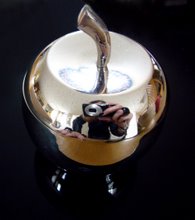
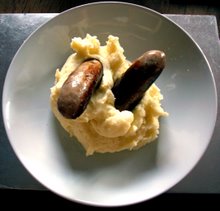

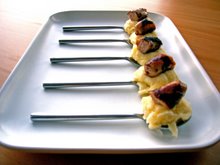

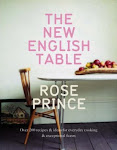
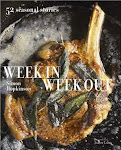
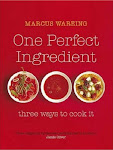

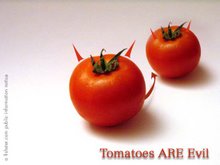
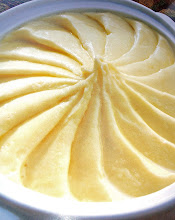

No comments:
Post a Comment